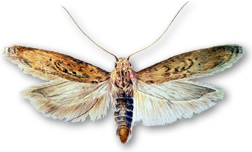|

Adult tuber moth. Chemicals emitted by the fungus Muscador
albus may help protect fresh spuds from the moth's destructive
larvae.Original image courtesy Central Science Laboratory, Harpenden
Archives, British Crown, and www.insectimages.org/.
|
|

|
Scientists Pit Fungus Against Potato Pest
By Jan
Suszkiw May 15, 2007
A fungus that packs a powerful biochemical "punch" may help knock out
potato tuber moths. That's the implication of an ongoing Agricultural Research
Service (ARS) study in which a blend of
alcohols, esters and other gaseous compounds emitted by the fungus Muscador
albus killed adult tuber moths and their larvae.
In the Pacific Northwest, where the moth (Phthorimaea
operculella) is a major problem, potato growers normally treat their crop
with broad-spectrum insecticides. However, some of the most effective
insecticides cannot be used within two weeks of harvest. In that interim,
surviving moths can lay their eggs on tubers destined for storage, notes
Lawrence
Lacey, an entomologist with the
ARS
Yakima Agricultural Research Laboratory, Wapato, Wash.
Together with
Lisa
Neven, an ARS entomologist there, Lacey is investigating M. albus'
potential as a biobased fumigant that could be used during that preharvest
period, as well as on warehoused potatoes.
Their investigation of the fungus is part of a larger program at
Wapato to diminish reliance on synthetic chemical controls by using biological
ones—including bacteria, viruses and roundworms—in integrated pest
management programs.
In lab experiments, the researchers placed adult moths and two-day-old
larvae inside special fumigation chambers and exposed the insects to one of two
concentrations of M. albus—15 grams and 30 grams—for 72 hours.
Exposure to volatile organic compounds emitted by the fungus at these
concentrations killed 85 and 91 percent of adult moths, respectively. Of the
larvae that escaped the fungal fumes, 62 and 73 percent of them died or failed
to become pupae, the final stage before they emerge as adult moths.
Lacey and Neven didn't discover M. albus, first found growing
on the bark of a cinnamon tree in Honduras, but they were the first to report
the insecticidal properties of its emissions. Research by other groups has
focused on M. albus' potential to kill other fungi and bacteria harmful
to crops or humans, as well as on its ability to degrade human and animal
wastes.
ARS is the U.S. Department of
Agriculture's chief scientific research agency.